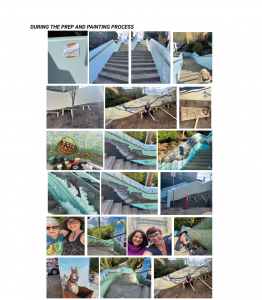Mural
Help Support Our Mural
Mural Activity/Coloring Book $9.99/each (shipping charges additional TBA)
To get your books please contact our office: info@RaleighHillsBusinessAssn.org
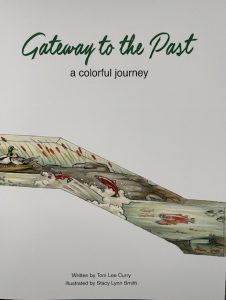
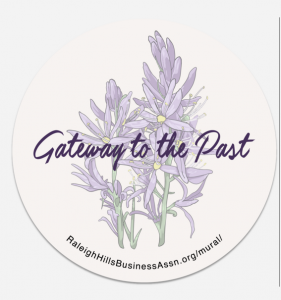
The Stairway mural photo-shopped to get a full visual effect.
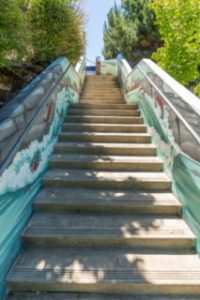
About the Mural: It started as a conversation with two businesses in Raleigh Hills who were concerned about tagging and vandalism. As the managers of Raleigh Hills Fred Meyer and Courtyard Village researched anti-graffiti protective covering, an idea for producing a public art project was born. Thanks to generous funding from Venture Portland, Explore Tualatin Valley and support from the Raleigh Hills Business Association, the Mural on The Stairs project began.



The active senior living community at Courtyard Village helped shape this project by providing invaluable feedback. They participated in surveys and discussions with our local historian Carolyn Woods. We felt that their inclusion and the connection and engagement with them emulated the tradition of respect for elders in the native culture. 
Our muralist, Stacy Lynn Smith, worked to tie in all the elements that were important to celebrate and appreciate here and now in Raleigh Hills. The Gorge was the lifeline for commerce, hunting, fishing and transportation. The outside wall pays homage to the Columbia Gorge. Special thanks to Bob Hansen for the beautiful text work that he contributed. The inside walls of the stairs celebrate the salmon, the wildlife and native plants that existed when the “first peoples” walked here, lived here and had their families here. It is their footsteps we honor. When people walk up or down the stairs they are embraced by the peace of the landscape as it was in those days
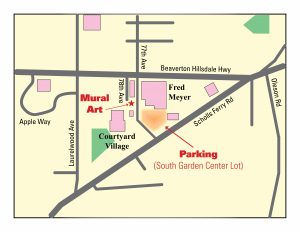
To view the mural, please park in the RH Fred Meyer parking lot, off SW 77th Avenue. There is no public parking at Courtyard Village.
Info contact RHBA: info@RaleighHillsBusinessAssn.org
https://raleighhillsbusinessassn.org/mural

![]() ~~~~~~~~~~~~~~~~~~~~~~~~~~~~~~~~~~~~~~~
~~~~~~~~~~~~~~~~~~~~~~~~~~~~~~~~~~~~~~~
The RHBA Mural Team Collaborated with the Muralists: Stacy Lynn Smith https://www.stacylynnsmith.com/ and Bob Hansen https://www.inknife.co/

RHBA received 2 Grants; 1 from Venture Portland https://ventureportland.org/ and the 2nd from Explore Tualatin Valley https://tualatinvalley.org/.



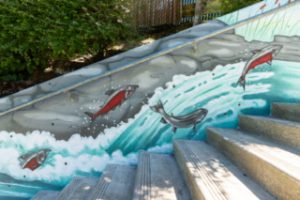



 The importance of the Camas Plants to our local History.
The importance of the Camas Plants to our local History.
- The Kalapoya natives came to Beaverton, OR area to harvest camas plants, which were a vital food source for them. They practice sustainable harvesting techniques, ensuring the plants thrived for future generations, and camas played a significant role in their cultural practices and seasonal ceremonies.
- Kalapoya Natives and the Beaverton Area
- Historical Presence
- The Kalapoya people originally occupied a vast area in the Willamette Valley. Including regions that encompass modern-day Beaverton, OR. They have lived in this area for over 14,000 years, developing a deep connection to the land and its resources.
- Importance of Camas Plants
- Camas plants were a vital food source for the Kalapoya. The bulbs of the camas plant were harvested and prepared as a stable in their diet. This plant not only provided nourishment but also played a significant role in their cultural practices.
- Harvesting Practices
- The Kalapoya practiced sustainable harvesting methods for camas, ensuring that the plants could thrive for future generations. They used traditional techniques, such as baking the bulbs in underground ovens, to make them edible. This careful stewardship of the land and its resources reflects their deep understanding of the ecosystem.
- Cultural Significance
- Camas are considered a cultural keystone species, integral to the identity and traditions of the Kalapoya. The plant’s growth stages were often used as seasonal markers in their calendars, linking their agricultural practices to the rhythms of nature. The Kalapoya’s presence in the Beaverton area was driven by the availability of the camas and other resources, which were essential for their survival and cultural practice.
- The Kalapoya natives came to Beaverton, OR area to harvest camas plants, which were a vital food source for them. They practice sustainable harvesting techniques, ensuring the plants thrived for future generations, and camas played a significant role in their cultural practices and seasonal ceremonies.
- Kalapoya Natives and the Beaverton Area
- Historical Presence
- The Kalapoya people originally occupied a vast area in the Willamette Valley. Including regions that encompass modern-day Beaverton, OR. They have lived in this area for over 14,000 years, developing a deep connection to the land and its resources.
- Importance of Camas Plants
- Camas plants were a vital food source for the Kalapoya. The bulbs of the camas plant were harvested and prepared as a stable in their diet. This plant not only provided nourishment but also played a significant role in their cultural practices.
- Harvesting Practices
- The Kalapoya practiced sustainable harvesting methods for camas, ensuring that the plants could thrive for future generations. They used traditional techniques, such as baking the bulbs in underground ovens, to make them edible. This careful stewardship of the land and its resources reflects their deep understanding of the ecosystem.
- Cultural Significance
- Camas are considered a cultural keystone species, integral to the identity and traditions of the Kalapoya. The plant’s growth stages were often used as seasonal markers in their calendars, linking their agricultural practices to the rhythms of nature. The Kalapoya’s presence in the Beaverton area was driven by the availability of the camas and other resources, which were essential for their survival and cultural practice.
- ~~~~~~~~~~~~~~~~~~~~~~~~~~~~~~~~~~~~~~
Follow the Mural on Instagram: #gatewaytothepast


